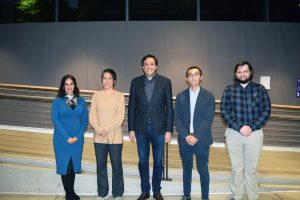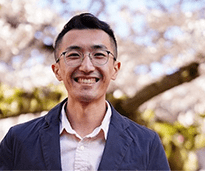I-Tung Chen is a Ph.D. student in electrical & computer engineering where he works in the Laboratory of Photonic Systems and is an Accelerating Quantum Engineering and Technology (AQET) Fellow in QuantumX.
QuantumX: When you graduated with a B.S. in materials science and engineering, what interested you in pursuing a Ph.D. in ECE at UW?
Chen: When I was at the National Tsing Hua University in Hsinchu City, Taiwan, I was fortunate to attend the American Physical Society (APS) March Meeting in Los Angeles. It was a mind-blowing experience and the first time that I listened to so many talks about quantum engineering and technology. I first noticed Professor Mo Li from UW ECE when I was applying for grad schools because his research in integrated photonics and optomechnical devices fascinated me. I saw the potential to combine my interest with his research to develop quantum technologies. I’m in my fourth year and it’s been a wonderful journey.
QuantumX: Describe the research you’re working on with him.
Chen: Dr. Li’s research focuses on using material vibrations — acoustic waves traveling inside materials — to control light propagation properties. We call this acousto-optics, or optomechanics in general. My research focuses on using optomechanics to create a link between two separate quantum chips. The problem we’re trying to answer is: can we use optomechanics to transfer the information on a quantum chip to a distant quantum chip through optical fibers efficiently? The project is both challenging and crucial for future quantum computers. More importantly, this aligns with my interest in developing quantum technologies, so I chose this as my research focus.
QuantumX: What interested you in the AQET training program?
Chen: AQET brings together graduate students interested in quantum information science. These students are studying physics, ECE, computer science, MSE and more. AQET offers courses to bridge the knowledge between different fields of research and provides an environment for students to learn from each other and work together. During these classes, I can work with students from different research groups, and the connections that we formed during the classes allow me to access research tools that I wouldn’t be able to otherwise. This helped me with my experiments and opened new possibilities in my research.
Quantum:Tell us about your AQET capstone.
Chen: I worked with a Microsoft quantum team in the AQET capstone program. Our project, “Integrate automatic Oracle Synthesis into QDK for resource estimation,” aimed to make quantum programming easier by automatically compiling classical codes into quantum logic gates that can be served as building blocks of quantum algorithms, and estimate the required quantum resource in Azure Quantum Resource Estimation that is developed by Microsoft. I’m looking forward to working with them as an intern this summer.
As a member of AQET, you invited and hosted IBM Senior Vice President and Director of Research, Dario Gil on campus. What was this experience like?

It was amazing and surreal. I could have never imaged that one day I can take Dr. Dario for a walk on the UW campus. And he is just an incredible person. I really appreciate him for sharing valuable insights on QISE with us, even though we are only students. The main reason we chose to invite Dr. Dario is because we have Microsoft, Amazon, IonQ, Google in the Pacific Northwest region, and they are all working on building quantum computers. As students, we want to learn from all the experts, so it was surprising to me that we don’t have much of a connection with IBM quantum, which is one of the biggest companies out there building quantum computers. I think inviting him here is just a start for something that will last way longer with a broader impact for our quantum community.
QuantumX: What’s next for you? What are your plans after graduation?
Chen: I plan to work in industry after I graduate. My research focus is on quantum transducer, which convert quantum information between disparate physical carriers. This work has been published by Nature Communication so I hope to find an industry position that can leverage my experience in transducer research or a related field in quantum computing.
What do you do for fun outside the lab?
I play French horn in the UW campus philharmonia orchestra every Tuesday night. I find rehearsing and practicing with other students is quite calming and a good way to reduce my stress when I’m not thinking about research and papers.
QuantumX: Any advice for students interested in pursuing studies in quantum information science and engineering?
I have observed that many students are interested in QISE but are unsure of their capability and knowledge in the quantum domain (quantum information/quantum mechanics, etc). Realistically, not every research group at UW is related to quantum information or quantum computing, if the students can participate in one of the related labs, that’s the best way to learn. But if this is not feasible, try to learn this through programming like Qiskit, Q# and Cirq, and by participating in quantum hackathons. Once the fundamentals are there, students should feel more confident studying QISE.

